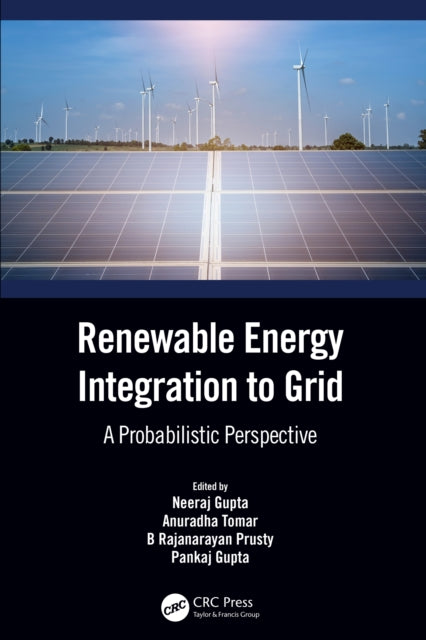Shulph Ink
Renewable Energy Integration to the Grid: A Probabilistic Perspective
Renewable Energy Integration to the Grid: A Probabilistic Perspective
YOU SAVE £6.24
- Condition: Brand new
- UK Delivery times: Usually arrives within 2 - 3 working days
- UK Shipping: Fee starts at £2.39. Subject to product weight & dimension
Bulk ordering. Want 15 or more copies? Get a personalised quote and bigger discounts. Learn more about bulk orders.
Couldn't load pickup availability
- More about Renewable Energy Integration to the Grid: A Probabilistic Perspective
The book provides analysis and modeling of renewable generation uncertainty for planning and operation, discussing the dependence modeling of multi-site renewable generations, probabilistic analysis, and various aspects of renewable energy integration. It is validated with case studies using standard test systems.
Format: Hardback
Length: 262 pages
Publication date: 25 March 2022
Publisher: Taylor & Francis Ltd
Here is the rephrased text:
Renewable generation uncertainty analysis and modeling are essential for planning and operation in the industry, benefiting professionals and researchers alike. This comprehensive text delves into the intricate modeling of multi-site renewable generations, covering probabilistic analysis and its practical applications for data analysts. It explores various aspects of renewable energy integration, including technical and economic considerations, while validating correlation factors and methodologies through case studies using diverse standard test systems. This resource is a valuable tool for those seeking to navigate the complexities of renewable energy integration and optimize its benefits.
Renewable generation uncertainty analysis and modeling:
Renewable generation uncertainty analysis and modeling play a crucial role in the planning and operation of the industry, benefiting professionals and researchers alike. This comprehensive text delves into the intricate modeling of multi-site renewable generations, covering probabilistic analysis and its practical applications for data analysts. It explores various aspects of renewable energy integration, including technical and economic considerations, while validating correlation factors and methodologies through case studies using diverse standard test systems. This resource is a valuable tool for those seeking to navigate the complexities of renewable energy integration and optimize its benefits.
Dependence modeling of multi-site renewable generations:
In the realm of renewable energy, the dependence modeling of multi-site renewable generations is a critical aspect to consider. This modeling involves analyzing the interdependencies between different renewable energy sources, such as solar, wind, and hydroelectric power, at multiple locations. By understanding these dependencies, policymakers and industry professionals can develop more effective strategies for integrating renewable energy into power systems.
One of the key challenges in dependence modeling is the accurate representation of the variability and uncertainty associated with renewable energy sources. These sources are inherently unpredictable due to factors such as weather patterns, wind speed, and solar irradiance. As a result, it is essential to develop robust models that can account for these uncertainties and provide accurate predictions of renewable energy generation.
One approach to modeling multi-site renewable generation is to use stochastic simulation techniques. These techniques allow for the simulation of the random behavior of renewable energy sources and their interactions with the power system. By running multiple simulations with different scenarios, policymakers and industry professionals can gain a better understanding of the potential risks and benefits of renewable energy integration.
Another important aspect of dependence modeling is the consideration of grid-level factors. Renewable energy sources are often connected to the power grid through transmission lines and other infrastructure. The behavior of these grid-level factors can have a significant impact on the performance and stability of the power system. Therefore, it is essential to incorporate grid-level factors into the dependence modeling process to ensure that renewable energy integration is done in a way that is compatible with the grid's requirements.
In conclusion, dependence modeling of multi-site renewable generations is a crucial aspect of renewable energy planning and operation. By accurately representing the variability and uncertainty associated with renewable energy sources, policymakers and industry professionals can develop more effective strategies for integrating renewable energy into power systems. Stochastic simulation techniques and the consideration of grid-level factors are important tools that can help achieve this goal.
Weight: 552g
Dimension: 162 x 240 x 23 (mm)
ISBN-13: 9780367747947
This item can be found in:
UK and International shipping information
UK and International shipping information
UK Delivery and returns information:
- Delivery within 2 - 3 days when ordering in the UK.
- Shipping fee for UK customers from £2.39. Fully tracked shipping service available.
- Returns policy: Return within 30 days of receipt for full refund.
International deliveries:
Shulph Ink now ships to Australia, Belgium, Canada, France, Germany, Ireland, Italy, India, Luxembourg Saudi Arabia, Singapore, Spain, Netherlands, New Zealand, United Arab Emirates, United States of America.
- Delivery times: within 5 - 10 days for international orders.
- Shipping fee: charges vary for overseas orders. Only tracked services are available for most international orders. Some countries have untracked shipping options.
- Customs charges: If ordering to addresses outside the United Kingdom, you may or may not incur additional customs and duties fees during local delivery.


